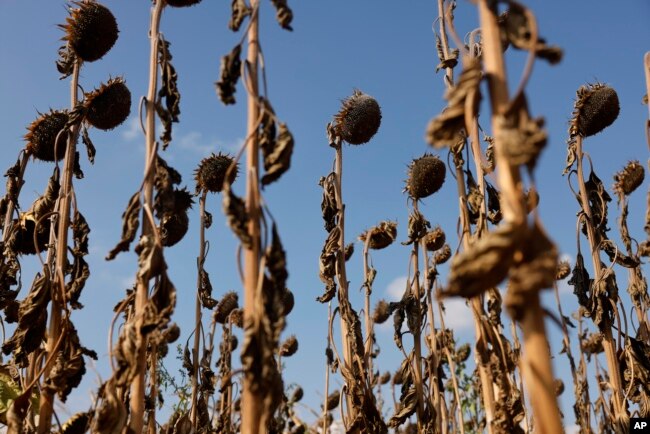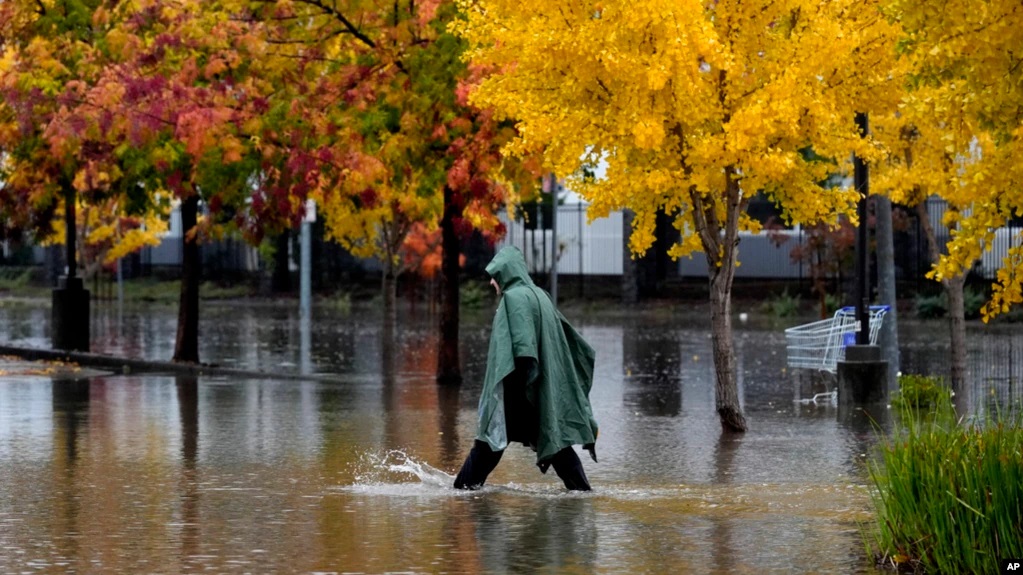In 2022, AP Photographers Captured Pain of a Changing Planet
Written by worldOneFm on December 30, 2022
In 2022, photographers with The Associated Press captured signs of a planet in distress as climate change reshaped many lives.
That distress was seen in the scarred landscapes in places where the rains failed to come. It was felt in walloping storms, land-engulfing floods, suffocating heat and wildfires no longer confined to a single season. It could be tasted in altered crops or felt as hunger pangs when crops stopped growing. And taken together, millions of people were compelled to pick up and move as many habitats became uninhabitable.
2022 will be a year remembered for destruction brought on by a warming planet and, according to scientists, was a harbinger for even more extreme weather.
Parched earth
In June, two young men sat smoking in front of a boat that had previously been under water. The waterline in parts of Lake Mead National Recreation Area in Nevada had dropped so much that the boat was now standing up in the mud. Such dramatic manifestations were seen in myriad places.
In Germany, drought combined with a bark beetle infestation left large swaths of Harz forest trees spindly, while in Kenya mothers struggled to keep their children nourished and animals died because of a lack of water. Along the Solimoes River in the Brazilian Amazon, houseboat dwellers found themselves living on mud instead of water, as parts dried up.
In eastern France, normally lush sunflowers looked as if they had been fried, their leaves withered, and seeds blackened. Similar scars on the Earth’s surface were seen in reef-like structures exposed by receding waters in Utah’s Great Salt Lake, the cracked bed of Hungary’s Lake Velence and the shrunken Yangtze River in southwestern China.
Storms and floods
While a lack of rain did damage in many places, in others too much precipitation altered landscapes and swallowed lives. Sometimes the same region, in a short amount of time, went from drought to deluge — what scientists refer to as a “whiplash effect.” This happened in parts of Yellowstone National Park last summer.
The country hardest hit by floods was Pakistan, with a third of its land submerged, millions of people displaced and at least 1,700 killed. But many countries were hit hard by storms.
In Cuba, a tropical cyclone in June led to so much flooding that rescuers moved through the streets of Havana in boats. Just a few months later, Hurricane Ian slammed into the island before continuing to Florida, leaving destruction and death in its wake.
Heavy floods were also seen in parts of Nigeria, India, Indonesia and numerous other places, while in one part of Brazil, a common aftereffect of flooding — landslides — killed more than 200 people.
To be sure, there were human attempts to better prepare and deal with flooding. One example: Chinese authorities continued to develop and expand “sponge cities,” which aim to use porous pavement and green spaces to absorb water and reduce the destruction of flooding.
Heat and fire
In recent years, wildfires have become commonplace across the Western U.S. amid a 23-year drought and rising temperatures. Compared to last year, there were slightly fewer wildfires in 2022 in California — the state routinely hardest hit — but many blazes still chewed through land and homes.
America was hardly alone. There were significant fires in Portugal, Greece, Argentina and many other countries. Images like a living room engulfed in flames, an evacuated woman clinging to a police officer and a man using a branch to protect his home were visceral reminders of the fury that fires unleash.
Along with fires, there were periodic bouts of extreme heat. A sweating British soldier, wearing a traditional bearskin hat outside Buckingham Palace, captured a reality for many Brits, as temperatures reached 104 degrees Fahrenheit (40.3 degrees Celsius), a record for the country.
How people coped with sauna-like conditions depended on the place. In Madrid, a fountain at an urban beach provided relief to parents and children. In Hungary, three people cooled off in a fill-up pool. And in Los Angeles, a woman stuck her head in front of an open fire hydrant.
Imperiled food
In October, Wilbur Kuzuzuk pulled a spotted seal to the edge of the lagoon in Shishmaref, a town in western Alaska that is on the verge of disappearing because of climate change.
The 600 residents of the Inupiat village have stayed put despite increasing risks to their way of life, including their food supply, as warming seas encroach on land and warming temperatures hurt habitats. But residents like Kuzuzuk know Shishmaref’s days are likely numbered: Twice the town has voted to relocate, though nothing has been put in motion.
All around the world there were clear threats to the food supply. In India, floods damaged corn and other crops, leaving farmers no choice but to try to salvage as much as possible. In Kenya and surrounding countries, drought increased hunger and pushed villagers to dig ever deeper in search of groundwater.
Climate migration
Taken together, all these problems pushed millions of people to migrate. Perhaps nowhere was that clearer than in Somalia, where severe drought led to starvation and prompted thousands of people to flee. Many migrants ended up in makeshift camps, like the one in Dollow, emaciated, young children in tow, desperately seeking food and water.
Much of the migration happened within borders. In India’s Ladakh region, a cold mountainous desert that borders China and Pakistan, shrinking grazable land, along with other effects of climate change, continued to force many to migrate from sparsely populated villages to urban settlements.
In Indonesia, a big driver of migration was encroaching seas. In Central Java, homes not outfitted with raised floors were swallowed, pushing those who didn’t have the means to seek other abodes.
In Kenya, a woman named Winnie Keben recounted how she lost her leg to a crocodile attack. She blamed the attack, in part, on the fact that rising water levels around Lake Baringo have brought animals closer to humans. Many scientists attribute that to climate change.
Keben’s home was also washed away, sending her family to another village.
AP












